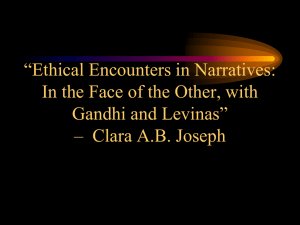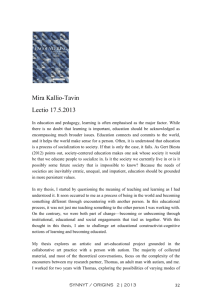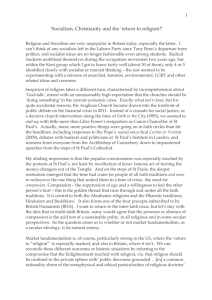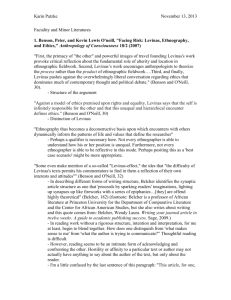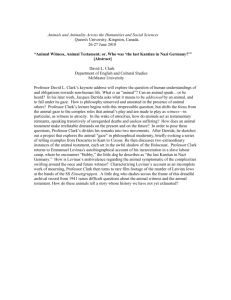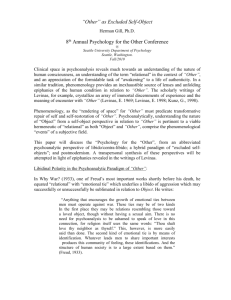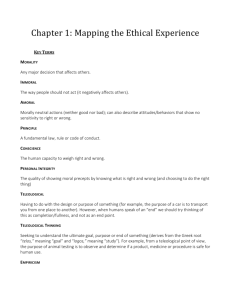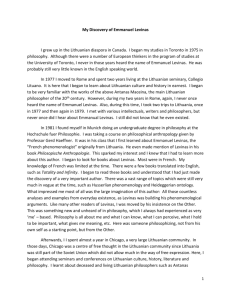Levinas Meets Macmurray and They Wonder If Psychotherapy Has
advertisement
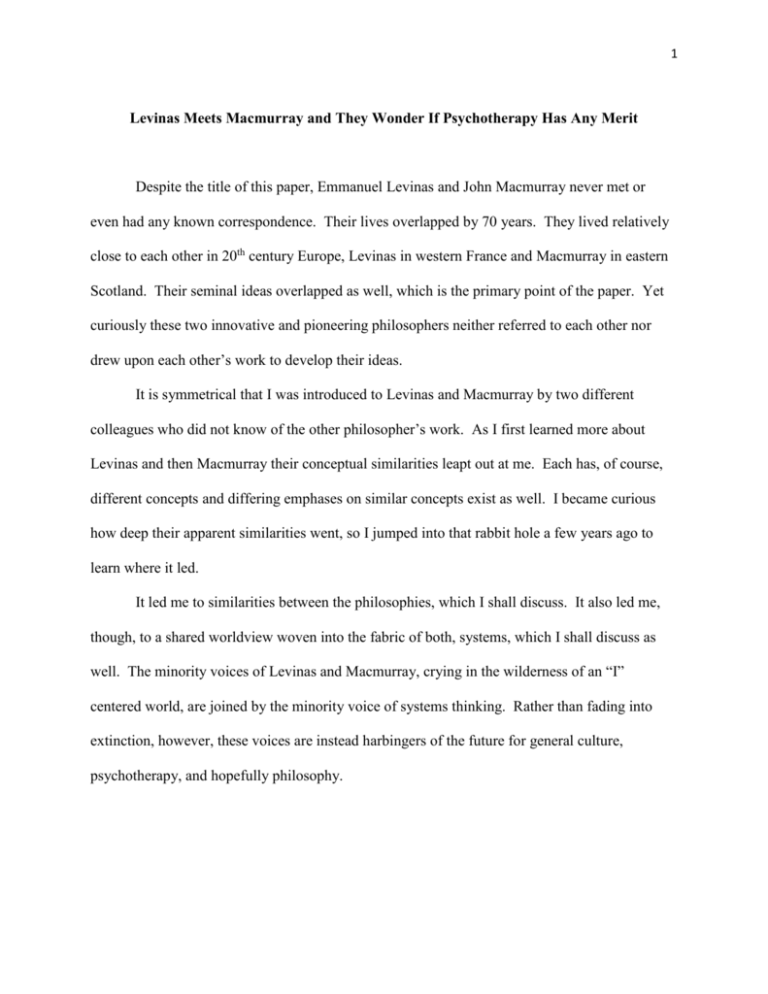
1 Levinas Meets Macmurray and They Wonder If Psychotherapy Has Any Merit Despite the title of this paper, Emmanuel Levinas and John Macmurray never met or even had any known correspondence. Their lives overlapped by 70 years. They lived relatively close to each other in 20th century Europe, Levinas in western France and Macmurray in eastern Scotland. Their seminal ideas overlapped as well, which is the primary point of the paper. Yet curiously these two innovative and pioneering philosophers neither referred to each other nor drew upon each other’s work to develop their ideas. It is symmetrical that I was introduced to Levinas and Macmurray by two different colleagues who did not know of the other philosopher’s work. As I first learned more about Levinas and then Macmurray their conceptual similarities leapt out at me. Each has, of course, different concepts and differing emphases on similar concepts exist as well. I became curious how deep their apparent similarities went, so I jumped into that rabbit hole a few years ago to learn where it led. It led me to similarities between the philosophies, which I shall discuss. It also led me, though, to a shared worldview woven into the fabric of both, systems, which I shall discuss as well. The minority voices of Levinas and Macmurray, crying in the wilderness of an “I” centered world, are joined by the minority voice of systems thinking. Rather than fading into extinction, however, these voices are instead harbingers of the future for general culture, psychotherapy, and hopefully philosophy. 2 Levinas and Macmurray Talk This section focuses on five overlaps between the two philosophers. The two also present concepts that not so much differ from each other as are not discussed by the other. That is, each had priorities seeming not shared by the other, so their discussions took some different turns. For example, Levinas (1969) stressed the outgrowth of oppression from totalizing, whereas Macmurray (1957, 1959) said relatively little about it. What excite me, though, are the similarities between them and their implications for this curious enterprise called psychotherapy. A first similarity was that Levinas and Macmurray were people of active religious faith and practice (Jung, 2002). Both were raised in a religious tradition that they continued in basic form their entire lives. Levinas was raised Jewish in the Musar tradition (Stone, 1998). Macmurray was raised in the Church of Scotland (the American Presbyterian Church is the most obvious United States descendent), though as an adult later in life he joined and remained in the Society of Friends or Quakers (McIntosh, 2004). I note this overlap first, as their religious views seem to undergird their philosophical views. Indeed, it is inevitable that worldviews which surround us as well as those that we choose influence us all consciously and unconsciously (Sue & Sue, 2008). Levinas and Macmurray were no different. The Jewish minority of Musars in eastern Europe prized the intellect of their faith. They strove to be liberal arts scholars as well as devout Jews. Growing up with this tradition in Lithuania, Levinas read widely, ingesting secular and sacred literature. Concerning the latter, he was immersed in his own tradition through the Torah and Talmud. He also read the Christian Bible, which helped him understand the broad Christian ethos that influenced the Europe of his day (Stone, 1998). 3 Macmurray grew up in a different religious and cultural tradition than Levinas. His Scottish upbringing was dominated by strict religious and life-style dogmas, which Macmurray shed when he began university studies as a young man. As a devout Christian, he read the Christian Bible, include the books that overlapped with the Torah, the Old Testament. Although his exposure to liberal arts sources began later than Levinas, Macmurray made rapid progress during his undergraduate and graduate studies (McIntosh, 2004). Learning about life and philosophy through overlapping sacred lenses might have contributed to a second similarity between the two: existence of the Other. Such a priori existence appears in the opening of the Old Testament: “In the beginning God…” (Genesis 1:1, International Inductive Study Bible, 1993). That is, the same God of the Jewish and Christian traditions is the primal Other who preceded all and indeed created all. Explanations for this divine creation abound. One interpretation that is consistent with both philosophers holds that the creation is an expression of infinite love by God who loved the cosmos a priori and then brought it into being (Pinnock, 2001). Here, then, is the divine template—“God is love,” (1 John 4:16, International Inductive Study Bible, 1993) and that love came before and resulted in the Other of humanity. The image of God, including the core of love, is inside of each person, since all are created by God as special (Genesis 1:27, International Inductive Study Bible, 1993). A third similarity ties intimately into the second: the primacy of the Other. Jung (2002) referred to this prioritization of both philosophers as first ethic. If God loved the cosmos, the original Other, prior to its existence and that love placed the cosmos first, then once more a template of prizing the Other appears, plus prizing the Other ahead of self. Capitalizing the first letter of “Other” by both philosophers symbolized the specialness each held for those in relationship (Levinas, 1969, Macmurray, 1957). Macmurray (1959, p. 77), for instance, implied 4 this divine sentiment in the early parent-child relationship by stating, “…first knowledge is the recognition of the Other as the person or agent in whom we live and move and have our being.” Levinas could have easily written the same words. Such loving and prizing does not exist for and in itself, though. A fourth similarity emphasized by Levinas (1969) and Macmurray (1959) is that these experiences operate in and require relationship. Such relations are reciprocal. They originate in what Levinas (1969, p. 198) called the face of the Other—“…the face speaks to me and thereby invites me to a relation incommensurate with a power to be exercised”—yet continue as co-created relations. It is a process of fission where the energy of love contributes to generation of yet more energy of love. It is also no coincidence that both expressed respect for the words of Martin Buber (1958) whose relational philosophy-theology echoed this theme of divinely inspired prizing of others. An associated conceptualization loops in at the juncture of the fourth similarity. In contrast to the dominance of the modernistic or Cartesian worldview that has dominated western civilization for the last nearly 400 years, another worldview has been rediscovered and is in a quiet ascendancy: systems. A systemic worldview regards the universe as operating in constant flux and change. The universe is dynamic, rather than fixed and static. This constant flow of flux and change is also reciprocal in that all elements, animate and inanimate, in the universe affect and are affected by each other. Such reciprocal flux and change tends to operate in stable patterns, but unpredictable or chaotic operations appear as well (Lorenz, 1993; Wolfram, 2002). Systems is a worldview that simultaneously attends to isomorphic processes at the subatomic level to the familiar macro level where humans live every day (Bertalanffy, 1968). Levinas (1969) and Macmurray (1959) did not overtly refer to systems thinking. It seems likely that neither ever heard of it. Both nevertheless suggested that (a) humans were linked to 5 and affected each other in continuous relationships, (b) these relationship were constantly shifting and changing, (c) people were only understandable and meaningful in the context of relationships, never in isolation, and (d) relationships were important in themselves, not merely as descriptions of links between people. As one who is impressed with these philosophers, it is no surprise that each of them came to recognize the systems around them, even if nobody taught them directly about it. The fifth overlap between Levinas (1969) and Macmurray (1957, 1959) regards action. That is, the face of the Other is not an abstraction or something to merely contemplate. The face demands a response by the perceiver—acting rather than passivity. As Macmurray (1957, p. 90) stated, “The Self, then, is not the thinker but the doer. In its positive doing it is agent.” In saying this, Macmurray was not eschewing thought. Instead he underscored action as a necessary priority in relationships wherein thought of the Other required acting upon the thought. Levinas (1982) was no less action oriented than Macmurray in saying, “…the relation to the face is straightaway ethical… whose meaning consists in saying: ‘thou shalt not kill’” (p. 87). Even though such tantalizing conversations never took place, the two philosophers left a large enough legacy of their views that those of us who are their descendants can seek to apply them in our own era. And I hold that fundamental applications are possible and necessary. Psychotherapy So a crucial question of this presentation and this conference: Does psychotherapy have merit? The answer is somewhat clear with Levinas and quite clear with Macmurray. That is, Levinas was not so sure about its value, while Macmurray had no objections. 6 Kunz (1998) joined Levinas in criticizing the totalizing effects of ego-oriented psychology. Psychology as a whole, including the psychotherapies ensconced in it, reflects the same me-first or me-only Cartesian perspective that all western hemisphere cultures embrace. The mainstream focus for psychotherapy and the unit of analysis in research is the individual, entirely or largely devoid of contexts that involved people as well as other influences (Kendall, Butcher, & Holmbeck, 1999; MacDonald, 1996). Ergo, Levinas would likely predict that psychotherapy is at best be of limited help and actually could be harmful or help perpetuate injuries, especially considering that many clients come to the enterprise wounded and vulnerable. A more effective perspective to therapy, in keeping with Levinas, is what Kunz (1998) called psukhology. Kunz (p. 10) discussed how the Greek root word for psychology meant a breath of inspiration, “…sustained by the life and love of others…” Such a relational orientation is a far cry from the radical individualism that is apparent in approaches like behavioral therapy. Relations are held to be vital in themselves by humanistic psychotherapists such as Carl Rogers and Alfred Adler (Mosak & Maniacci, 2010; Raskin, Rogers, & Witty, 2010), which moves closer to the stance of Levinas. Even so, humanistic therapies developed in and remain guided by Cartesian thinking where self starts with the individual rather than the Other. The spirit of Levinas cum Kunz is better served through the systemic therapies whose origins are in relational thinking and acting. Such systemic therapies as Bowen Family Systems Theory (Kerr & Bowen, 1988) and Narrative Therapy (White, 1995) move even closer to the vision of Levinas yet still stop short of his first ethic. Macmurray (1959) spoke abundantly about psychology in general and psychotherapy in particular. Curiously, he railed against the self-centered orientation of philosophy yet withheld criticizing other fields founded on the same view. Following the gist of his discussion, he 7 seemingly thought that various fields, including psychology, had something to offer humanity despite the glaring flaws in their foundations. Perhaps he also held his own field of philosophy to a higher standard. It is possible that Macmurray (1959), like Levinas, was in effect a systemic or protosystemic philosopher. The spirit of his views appeared in his regards for family life as the primal grounding for a relational life with the Other: …the discriminated Other as a unity…is conceived personally, the conception is most naturally and most effectively expressed in terms borrowed from family unity. The family, indeed, is the natural model for any more inclusive group of persons conceived as a personal whole. (p. 109) I suspect that Macmurray would especially have been fond of the family therapy applications of systems that were just being born in his seminal years. In the introduction I referred to Levinas and Macmurray as innovators and pioneers. This might seem like an odd characterization, considering that their philosophies have been overlooked or deemphasized by many. Even so, I maintain that both provide essential conceptualizations that psychology and related fields could use in their own maturation, particularly for the people they serve, as I will discuss in the next section. Potential Applications Systemic thinking and acting are the future (MacDonald, 2008). In some settings the future is already here. Its exact future forms, of course, remain unknown. It is impossible to predict with certainty that a systemic worldview will eventually guide western civilization as modernism has. Significant movements in social and physical sciences over the past 30 years, 8 however, indicate a trend line in this direction. Developments of systems-related models help guide quantum mechanics and studies in theoretical physics such as String Theory (Greene, 1999) and Complexity Theory (Wolfram, 2002), for instance. Bertalanffy (1968) derived and applied his model of systems to biology. Even popular magazines (Holt, 2006) and television shows (McMaster, 2003) are starting to introduce String Theory and other topics from physics to the general population, in a trickle-down effect that commonly begins in the sciences. Social science applications are already underway, notably in psychology (Barton, 1994; Guastello & Liebovitch, 2009) and counseling (Carns & Carns, 1997) as well as what had already been noted about applications in family therapy. All of the developments just mentioned, though, would operate with greater teleology, meaning, and service to the populace when firmly guided by pertinent philosophies. Levinas and Macmurray have such philosophies. Either would pertain nicely alone. Together, however, they provide important cross-validation through their philosophical similarities and through their compatibility with systems thinking. In addition, their different emphases afford a diversity of ideas that could simultaneously stimulate developments in a variety of directions. Psychotherapy ethics and, in turn, their protection of clients would benefit from philosophical guidance, notably Levinas and Macmurray. Indeed, Levinas (1982) said that ethics began with the face of the Other. Each of the major guilds that entail psychotherapy (e.g., American Association for Marriage and Family Therapy, American Psychiatric Association; American Psychological Association,) uphold an ethical prime directive of client welfare and respect. This professional value could tie directly into the primacy of the Other. Ever since the Tarasoff decision (1976), however, professional organizations have largely revised their ethical codes in a reactive stance to the threat of lawsuits rather than with professional goals in mind. 9 That is, upholding client welfare and respect helps protect the therapist whether or not it serves the client. Regrettably, efforts to take a proactive stance on ethics that would derive from careful consideration of philosophical principles have been largely abandoned. Such a stance leaves these organizations without a compass and dependent upon the latest legal ruling that has implications for psychotherapy (MacDonald, 1996). A better approach, of course, would be to intentionally, systematically consider and incorporate philosophical principles as beacons to follow. Levinas and Macmurray are natural beacons for such a purpose. It is quite possible that other applications exist as well. The two I briefly describe convey that Levinas and Macmurray would be assets in the development of psychology and psychotherapy. Ever since psychology prematurely left philosophy in the nineteenth century and declared itself an empirical discipline, the guild has been rudderless (MacDonald, 1996). Related professions such as family therapy have direction but still lack the orientation that clear semantics provide. Such meanderings are unnecessary and are avoidable. Conclusion Perhaps in a way Levinas and Macmurray did meet. They left us a wealth of complex ideas that warrant unpacking and comparing decades after both stopped walking the earth. They independently created philosophies that overlap in significant ways and provide guidance for the current generation. Even their different emphases could prove fruitful in developing nuances of psychology and psychotherapy that help its practitioners serve their Others in meaningful ways. All in all, these pioneers independently provided a counter-cultural schema for understanding and negotiating the mainstream culture of the western hemisphere, including psychotherapy. We owe them a debt that, frankly, many have yet to recognize. 10 References Barton, S. (1994). Chaos, self-organization, and psychology. American Psychologist, 49, 5-14. Bertalanffy, L.v. (1968). General System Theory: Foundations, development, applications. New York, NY: George Brazilier. Buber, M. (1958). I and thou (2nd ed.). New York, NY: Charles Scribner’s Sons. Carns, A. W., & Carns, M. R. (1997). A systems approach to school counseling. The School Counselor, 44, 218-223. Greene, B. (1999). The elegant universe. New York, NY: W.W. Norton. Guastello, S.J., & Liebovitch, L.S. (2009). Introduction to nonlinear dynamics and complexity. In S.J. Guastello, M. Koopmans, & D. Pincus (Eds.). Chaos and complexity in psychology (pp. 1-40). New York, NY: Cambridge University. Holt, J. (2006, October 2). Unstrung. The New Yorker, 82 (31), 86-91. International Inductive Study Bible (1993). Eugene, OR: Harvest House. Jung, H.Y. (2002). Responsibility as first ethics: Macmurray and Levinas. In D. Fergusson & N. Dower (Eds.), John Macmurray: Critical perspectives (pp. 173-188). New York, NY: Lang. Kendall, P.C., Butcher, J.N., & Holmbeck, G.N. (1999). Handbook of research methods in clinical psychology (2nd ed.). New York, NY: John Wiley & Sons. Kunz, G. (1998). The paradox of power and weakness: Levinas and an alternative paradigm for psychology. Albany, NY: State University of New York. Levinas, E. (1969). Totality and infinity. Pittsburg, PA: Duquesne University. Levinas, E. (1982). Ethics and infinity. Pittsburg, PA: Duquesne University. Lorenz, E.N. (1993). The essence of chaos. Seattle, WA: University of Washington. 11 MacDonald, D. (1996). The conscience of psychotherapy. Winifred Weter Faculty Award Lecture, Seattle, WA: Seattle Pacific University. MacDonald, D. (2008). A dynamical successor to modernism and postmodernism. Counseling and Values, 52, 145-155. Macmurray, J. (1957). Self as agent. London, UK: Faber & Faber. Macmurray, J. (1959). Persons in relation. London, UK: Faber & Faber. McIntosh, E. (2004). Introduction. In E. McIntosh (Ed.), John Macmurray: Selected philosophical writings (pp. 1-12). Exeter, UK: Imprint Academic. McMaster, J. (Executive Producer). (2003). The elegant universe. (DVD No. WG6779.1 & WG6779.2) Boston: WGBH Educational Foundation. Mosak, H.H., & Maniacci, M.P. (2010). Adlerian psychotherapy. In R.J. Corsini & D. Wedding (Eds.). Current psychotherapies (9th ed.). Belmont, CA: Thomson Brooks/Cole. Pinnock, C.H. (2001). Most moved mover: A theology of God’s openness. Carlisle, UK: Paternoster. Raskin, N.J., Rogers, C.R., & Witty, M. (2010). Person-Centered Therapy. In R.J. Corsini & D. Wedding (Eds.). Current psychotherapies (9th ed.). Belmont, CA: Thomson Brooks/Cole. Stone, I.F. (1998). Reading Levinas/reading Talmud. Philadelphia, PA: Jewish Publication Society. Sue, D.W., & Sue, D. (2008). Counseling the culturally diverse (5th ed.). Hoboken, NJ: John Wiley & Sons. Tarasoff v. Board of Regents of the University of California, 17 Cal. 3rd 425, 551 (1976). Wolfram, S. (2002). A new kind of science. Champaign, IL: Wolfram Media.
